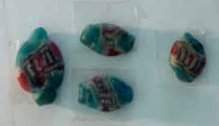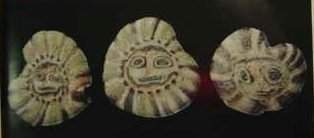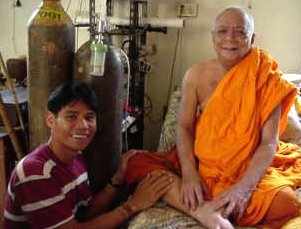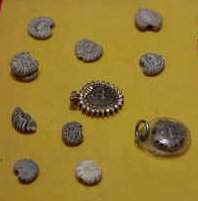The Bead Site =Home>Ancient Beads> Southeast Asia
|
|
|
Face Beads, Mosaics and Bead Study in Thailand
The following correspondence among Jim Lankton, Peter Francis, and Stefany Tomalin was prompted by Jim's recent trip to Thailand. Jim, Peter and Stefany are all members of Beads-L Discussion Group of the global interactive bead database project.
Jim Lankton is a volunteer with The Bead Museum DC, Peter Francis is head of the Center for Bead Research, and Stefany Tomalin is author of Beads! and owner of a shop by the same name on Portobello Road, London.
The goal of the global interactive bead database project is to develop an easy-to-use, searchable database on the web with images and data on beads from all over the world. A description of the project can be found at http://home.attbi.com/~judvan.
The Bead Museum DC and The Bead Museum, Glendale, Arizona are hosting a session at Bead Expo to discuss Bead Classification and Databases. For more information, contact Deborah Zinn, Beads-L convenor at dzinn@werple.net.au
Note: The global interactive bead database project and Beads-L support ethical and responsible bead collecting. For more information, consult the Guidelines for Bead Research of the Society for Bead Researchers at: http://www.mindspring.com/~larinc/sbr/research/research.htm
____________________________________________________________________
Saturday, 15 January, 2000
Dear Bead Listers,
Greetings to all from Amazing Thailand.
I've been here for the past week doing a sort of bead study tour cum vacation. I started in Bangkok, then set out for the south of Thailand, stopping first at the old city of Chaiya, a center for the Srjivijaya Kingdom, which stretched from Sumatra to Malaysia and Southern Thailand, and dated from the 8th to the 13th C.
The National Museum in Chaiya has beads from excavations in the Chaiya and Surat Thani districts, with most of the material from the 9th C AD. Both stone and glass beads have been found. The glass beads are primarily monochrome Indo-Pacific type, although eye beads, small blue beads with white stripes, and gold glass beads were excavated as well.
There is evidence for glass bead making in the area, although the chief of the museum, Ms Nongkran Srichai, suggested that the eye beads may be imports from Khlong Thom, a much larger site on the Western side of the Thai/Malay peninsula.
From Chaiya we went to the city of Nakhon Si Thammarat, also a Srivijaya area. The National Museum there has a number of beads found in the surrounding areas, although most are not from well-documented excavations. The beads found were similar to those from Chaiya.
Our next stop was the town of Khlong Thom, the best known site in Southern Thailand. Controlled excavations suggest occupancy and bead making from the 4th to the 9th C. The Abbot at Wat Khlong Thom, Phakru Arthron Sungworakit, has been active in promoting research at the site, also known as Khuan Lukpad, or "Bead Hill."
The Abbot has set up a museum at the Wat, or monastery, which displays many of the most interesting glass and stone beads. Many of these beads appear to have been made in the area, while others are probably imports. In addition to small monochrome drawn beads and large amounts of glass cullet, glass beads made of mosaic canes, including some unusual "face" beads, have been excavated, usually by uncontrolled excavations. In addition, I saw about 10 of the black oblate beads with white bird and star designs more common in Indonesia, but found at Thai sites as well [And Vietnamese - PF].
I was able to see an area of excavation at Khuan Lukpad, where several workers were digging a gravely sand, then washing and sorting for glass or stone beads. Very hard work in the hot sun. The beads found are offered for sale, often for very high prices for anything other than the common monochrome glass beads.
Khuan Lukpad is quite a large site. I don't know to what extent Khuan Lukpad has been properly surveyed, but I wonder if there isn't possibly an opportunity for accommodation between the needs of archeologists for historical knowledge and villagers for extra cash.
I'll try to include three photos. The first will be a close-up of the small mosaic face beads, taken from a Thai publication on the beads from Khlong Thom. The beads themselves are in the Museum, but quite small (the largest less than a cm in diameter, and difficult to see in the photo I took.
 |
The second photo is from the Khlong Thom museum, showing some beads made with mosaic canes.
 |
Here's the photo of the face beads found at Khlong Thom. I don't know of any comparable face beads from anywhere else. If these were imports, where were they imported from? Perhaps the face canes were imported, then made into beads at Khlong Thom, thus explaining the unusual radial glass pattern around the face. All of the face beads or fragments at the museum were essentially identical in form and size.
The third photo is of the Abbot, who now is in poor health with pulmonary disease, but became very animated when talking about beads.
 |
Jim Lankton
Sunday, 16 January, 2000
Dear James,
Sounds like you are having a great time. Thailand is a wonderful place. The eye beads at Chaiya are not likely from Khlong Thom, but from Takua Pa, Thailand, which was contemporary. Khlong Thom is an older site. Takua Pa also may have made the small blue striped beads.At least there are some clumps of them found there.
Chaiya's glass and stone beads resemble those found at Palembang [Sumatra, Indonesia], the capital of Srivijaya, where they were certainly made. I've seen no evidence of Indo-Pacific beadmaking at Chaiya, but they may have made stone beads, at least the white, friable flint that can be dyed.
There have been several archaeological surveys of Khlong Thom, done by the FAD/Department of Archaeology and another by Ben Bronson. They are all dismayed because the place is so heavily looted that there is virtually no where left to excavate. Villagers would get economic benefit out of a scientific excavation, because they would be paid to do the work. However, the antiquities dealers of Bangkok got there first.
The mosaic face beads are well known Roman-period beads, almost certainly made in Alexandria. They are fairly common in the first and second centuries AD.Along with seals from India, a Han bronze mirror and a few other objects from Khlong Thom, it seems most likely to me that it was the western port of Funan, known in the ancient literature as Takkola.
Some had identified Takkola with Takua Pa, but we now know that Takua Pa was occupied only in the ninth century. Khlong Thom, along with Oc Eo (Vietnam) and Kuala Selinsing (Malaysia) were all Indo-Pacific beadmakers within the Funan state.
Peter Francis
Sunday, 16 January, 2000
Dear Peter and Beads-L,
Thanks for your response to my message about Thai beads. Regarding beadmaking near Chaiya, I based my suggestion that glass beads were manufactured there on reports by Basa in Southeast Asian Archeology, 1990, and Ratcharit, 1985, quoted by Basa. I'm sure you're familiar with this report, Peter, but it seems that the finds of glass fragments and a "glaze" of glass beads adhering to the surface of a brick were sufficient to suggest to Basa that glass beadmaking occurred.
I believe that the "Takua Pa" site you mention is actually the island of Ko Kho Khao, located 11 km off the mouth of the Takua Pa river north of the island of Phuket on the western coast of the Thai peninsula. It seems like several of these islands in the Andaman Sea were important trading posts, occupied over many centuries.
Basa mentions that Ko Kho Khao may have been a manufacturing center of blown glass vessels as well as beads, and describes a "common bead type" as a spherical bead "with a body of black and white stripes and with five eyes of yellow on red with a darker red boundary between yellow and red." I've looked for similar beads at the museums in Chaiya and Nakhon Si Thammarat, but didn't see any.
I've enclosed a photo I took of the mosaic face beads in the Wat Khlong Thom Museum. Although the faces do not show up well, you can see that all 11 of the beads and fragments are very similar, both in size and design. I estimate that the complete beads are a little less than 1cm in diameter. One of the face beads has been mounted as a pendant with gold and small diamonds. I understood from the abbot that these are all of the face beads found at Khlong Thom, although I don't know for sure.
 |
Regarding their place of manufacture, I've seen lots of face beads from "Alexandria," both oblate and tabular, but not one with the same kind of crude face or the radial surround pattern. [See comments below from Stefany Tomalin and Peter Francis about 'Sunbeams'.] Although we say "Alexandria" as a source for mosaic face beads, I seem to recall that no face beads have ever been found in Alexandria itself.
It seems there's a lot we don't know about these well known and popular beads. Incidentally, I recently saw a number of tabular face beads, all very similar in color and form, said to be coming from Shiraz. It seems possible that face beads were manufactured in several different places, perhaps with certain regional differences.
Wouldn't it be useful if we could post the various types of face beads found in documented excavations or at least locations! We could then begin to compare and contrast the various types, looking for evidence of regional manufacture or distribution.
Although the Khlong Thom face beads were not excavated formally, I think we can say with some certainty that they were found in the area of Khlong Thom, and at a site generally dated from the 4th to the 9th C, with some finds seeming to date even earlier (certain intaglio seals for example), I think even this sketchy information would be a big improvement. For example, photographs of the Khlong Thom face beads, although published by the Silpakorn University, have not been generally available outside of Thailand. I've wondered for some time what they might look like, but hadn't been able to find out until coming to Thailand.
Best regards to all.
Jim
Monday, 17 January, 2000
Dear James,
I've extracted some of your points and am replying to them. Before proceeding I want to tell you how impressed I am with your scholarship.
(Jim) Regarding beadmaking near Chaiya, I based my suggestion that glass beads were manufactured there on reports by Basa in Southeast Asian Archeology, 1990, and Ratcharit, 1985, quoted by Basa.
(Peter) Yes, I know the report, but I don't think this is sufficient evidence. I saw no evidence for local glassworking at the Chaiya Museum.
(Jim) I believe that the "Takua Pa" site you mention is actually the island of Ko Kho Khao, located 11 km off the mouth of the Takua Pa river
(Peter) It is the island of Koh Kho (Khao is "island"). It is not 11 miles in the sea. It is in the Takua Pa River estuary; I can confirm that personally. As with many sites, this one has multiple names. An archaeological site might be named for various things. Takua Pa is the nearest village.
Arikamedu (India) is also called Virampatinam after the village next to it. Kuala Selinsing has no less than four names. Khlong Thom is also called Kuan Lukpad ("bead mound"). It becomes difficult to talk about these or write about them when there are multiple names. I generally stick to the oldest and/or the most common.
(Jim) It seems like several of these islands in the Andaman Sea were important trading posts, occupied over many centuries.
(Peter) I know of no islands in the Andaman Sea that were important ancient trading posts except maybe for Phuket. Most of the ports were in river estuaries, which provide good places for ships to anchor.
(Jim) Basa mentions that Ko Kho Khao may have been a manufacturing center of blown glass vessels as well as beads, and describes a "common bead type" as a spherical bead "with a body of black and white stripes and with five eyes of yellow on red with a darker red boundary between yellow and red." I've looked for similar beads at the museums in Chaiya and Nakhon Si Thammarat, but didn't see any.
(Peter) I don't know this bead, either, and have no idea what he is talking about here. The "Takua Pa eye bead" has a dark (blue or green) body and several large irregular and irregularly spaced blue on white stratified eyes. The bead is called that because it was first described from Takua Pa and may have been made there, though that is not absolutely certain. I think it was part of the diaspora of Middle Eastern glassmakers. Aside from Han China, you never find stratified eye beads in Asia.
(Jim) I understood from the abbot that these are all of the face beads found at Khlong Thom, although I don't know for sure.
(Peter) There are at least 14 face beads recorded from Khlong Thom.
(Jim) Although we say "Alexandria" as a source for mosaic face beads, I seem to recall that no face beads have ever been found in Alexandria itself.
(Peter) We know very little of any sort of beads from Alexandria because it is Egypt's second city and very much alive. You can't excavate under a city. There are many places like this, When I was in Puebla, Mexico I visited the site of the first Mexican glass factory founded in 1542. They may have made beads there, but we won't know for a long time, as the whole block is built up of solid brick and stone multi-storied buildings.
(Jim) I recently saw a number of tabular face beads, all very similar in color and form, said to be coming from Shiraz. It seems possible that face beads were manufactured in several different places, perhaps with certain regional differences.
(Peter) I lived in Iran for three years and only saw a very few mosaic beads, never a face one. There could be a few there. However, it would take more than a few beads "said to be from Shiraz" before we could draw conclusions that they were made there. I strongly disbelieve that that is the case. Any old mosaic beads found in Iran would have been imports from Egypt or somewhere nearby.
(Jim) Although the Khlong Thom face beads were not excavated formally, I think we can say with some certainty that they were found in the area of Khlong Thom, and at a site generally dated from the 4th to the 9th C, with some finds seeming to date even earlier (certain intaglio seals for example).
(Peter) Your dating is too late for Khlong Thom. The beads are probably 1st-2nd century. We do not need the Khlong Thom beads as examples. There are well excavated examples in the West. See S. M. Alexeeva 1971 Les mosaiques miniatures dans les parures de verre datant au Ier siecle avant notre ere - du IIe siecle de notre ere Soviet Archaeology 4:182-5 + 2 pls. Plate 2 has no less than 20 variations on this mosaic plaque.
Peace
Pete
Tuesday, 18 January, 2000
Hello -
I only wanted to comment on Jim's face beads as depicted. About the radiating lines surrounding the faces. As you probably know, especially if you have ever done enamelling involving melting patterned millefiori canes, any small slices of round canes with an outer layer or "border" of lengthways strands or stringers of contrasting colours of glass will appear as a circle of dots round the edge, but when melted the outside edge of the glass spreads and flattens, giving the appearance of radiating "Sunbeams". I bet it wasn't constructed with built-in sunbeams!
Stefany (Tomalin)
Wednesday, 19 January, 2000
Hi Stef and all,
Stef is correct that at the edges what are dots on a slice of cane spread out to make rays. For many years I have been referring to these as "lashes" when found on mosaic eye canes. I think the cane makers knew this would happen. Some face pendants show this, while others were made with elements that represent hair.
However, as Jim pointed out (but did not get reproduced here), these beads were not melted onto a surface. Rather they are slices of canes perforated through the edge. The rays are part of the cane's design.
Peace
Pete
Notes:
The correspondence has been edited by Deborah Zinn and Pete Francis.
The copyright of this correspondence belongs to the correspondents.
Only websites affiliated with the global interactive bead database project and Beads-L
are permitted to reproduce this article on their websites.
__________________________________________________
Small Bead Businesses | Beading & Beadwork | Ancient Beads | Trade Beads
Beadmaking & Materials | Bead Uses | Researching Beads | Beads and People
Center for Bead Research | Book Store | Free Store | Bead Bazaar
Shopping Mall | The Bead Auction | Galleries | People | Events
The Bead Site Home | Chat Line | Contact Us | Site Search Engine | FAQ
